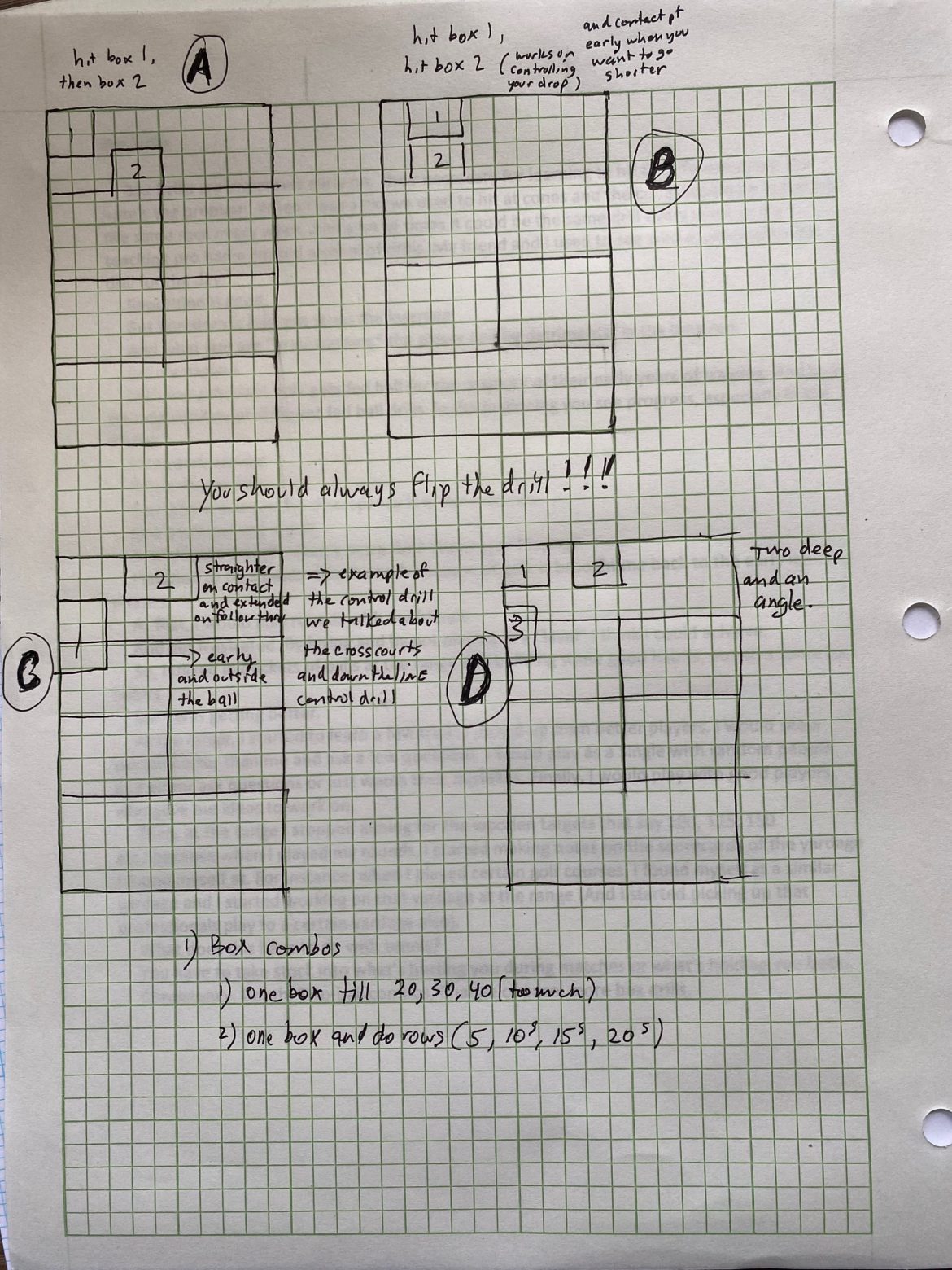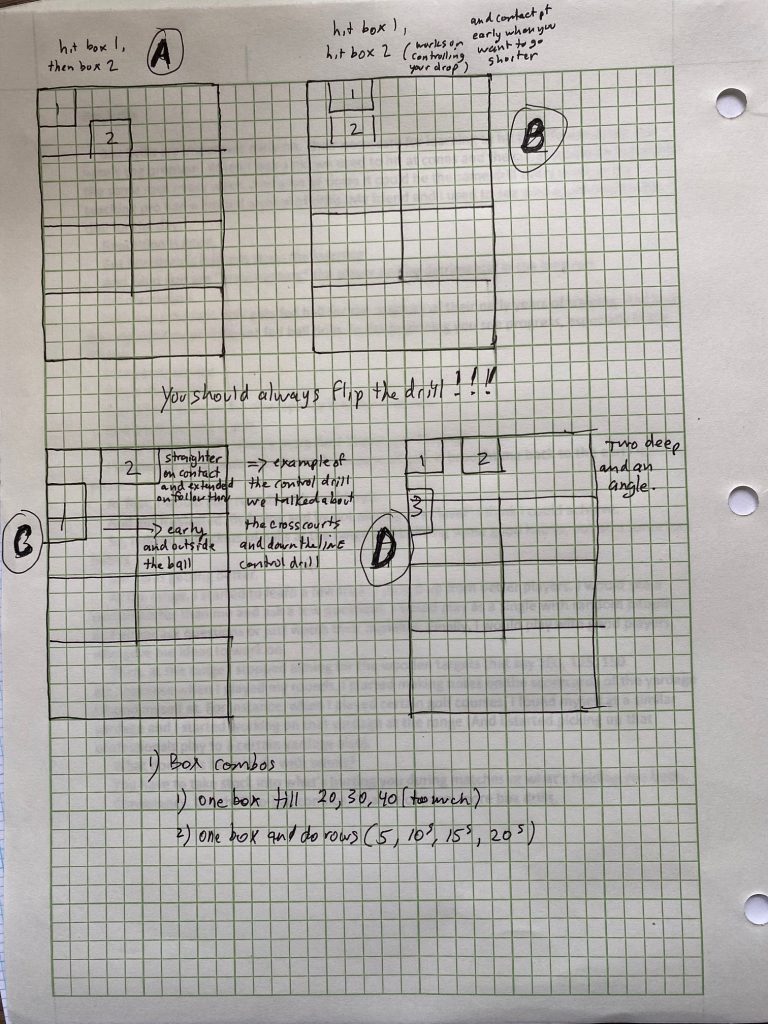Coach and analyst Evan Gaudreau is back with an interesting post about box drills. Give them a try and let me know what you think.
Ps. Check out Evan’s other content here. Ds.
And support Tennisnerd and get more insightful articles and videos via my Patreon.
Box Drills – by Evan Gaudreau
Box Drills are important early on. They’re necessary for learning to hit to different areas. But here’s the problem. When I was a kid, we hit at cones and the cones would be in roughly the same spot every week. And a lot of times, it could be the same drill every week or if a teaching pro had a limited arsenal of drills. My friend and I used to see who could predict the drill for the day.
Repetition is good. But boredom is bad and stops the learning. And what you are “brainwashing” the player can be detrimental in the long run. Let me explain.
A student only gets fed ball for the majority of their early years of training. And their training consists of different fed ball drills. In the beginning, you see progress, especially in the hitting. More consistency. Better footwork. But, where you see the discrepancy is in the matches.
Use golf to improve your tennis
One analogy I use is golf. In any sport, though, what’s more fun? Training or Playing? I learned to be a better tennis coach because of golf. It brought me back to the early learning phases.
At first, I would play rounds with my friends. And get frustrated. By losing and by not playing at a “level” I think I could achieve. So, I mixed in buckets of balls at the range and built some good habits and some bad habits. But I was getting better.
At the range, I learned a few tricks I picked up from better players. I would see a person better than me and ask a few questions. I would play as a Single with random people and either ask questions or watch their mistakes. Finally, I would play with good players who gave me ideas to work on.
Then, at the range, I stopped aiming for the wooden targets that say 100, 125, 150 etc…because when I played my rounds, I started making notes on the scorecards of the yardage I found myself at. For instance, when I played certain golf courses, I found myself at similar yardage and I started working on that yardage at the range (And I started picking up that professionals play to certain yardage also).
What’s hurting you in matches?
What does this have to do with tennis?
You have to take stock of what’s hurting you during matches or holding you back. And we are generally playing for short balls. So, work on those too!
Consistency, Depth, Two-ball combos, Change of pace, more box drills. And create more holes in your opponent’s game.
In box A drill, it’s a deep corner shot and then a shorter drop in the middle of the Deuce side. I wouldn’t look at this as a strategical combo. I would look at it as a control combo. A feel combo. This drill will teach you why you hit the ball short because you can “FEEL” it and not be told.
Why is that important?
Because being told is listening to someone else’s version. “FEELING IT,” on the other hand, makes it a part of you. It helps the player understand the difference and it solidifies the training in the mind.
Box B
Box B drill is slightly different. The swing path doesn’t change. The only thing that changes is where you contact the ball and how you finish the swing. To hit Box 2, you have to contact the ball a little earlier and “Break” the finish quicker. And to get the ball deeper, you can hit through the ball and the finish will extend more…or will it?
Experiment with the swing!
For instance, I’ll hit the ball “regular” in this drill and then use a “buggy whip” like Nadal. Except I’m older and have been doing this almost before he was born (When I was 16, he was probably 6). I’ll also use a ‘flick” swing to activate my wrist. It’s almost like a windshield-wash swing. And then I’ll mix the “flick” with an abbreviated finish.
Why?
Because when someone comes to the net and I know how to flick the swing, I can wait until the last second and get him to commit (hopefully) to cover the line and then flick crosscourt. The shot is sneaky and hard to read. It goes with my personality.
Box C
In the Box C drill, you can hit an angle, which makes you get around the outside of the ball and contact a bit earlier, and then hit the next shot deep middle, by pulling the contact back and hitting a straighter swing path.
I’d rather do these drills than the drill where the player goes crosscourt and then the other player goes down the line.
Box D
In box D, you can combine the two deep shots and then the angle. YOU CAN FLIP THE NUMBERS ANY WAY YOU WANT! I suggest it to understand the contact point better and so it doesn’t get “set” or “brainwashed” into your mental system.
Training
1) Single box hitting. Just make one box and have the player hit into it and go for (5,10,20 or whatever number you want). Don’t do it for 5 years though. Once you see improvement, start introducing a second box so they can start working on two box combos. This helps the learning process and makes the player adapt quicker.
You can also have the player hit into a target area 10 times, 3 times. Once they get to 10, do it again. This breaks up the training. And it’s easy to do something once. The funny thing about novice tennis players is that because they do something once, they think they don’t have to do it again.
2) The player has to hit into the box area 5, 10, 15, or 20 times in a row. And you can make them do it 2,3,4 times in a row (depending on what the issue is).
Funny story from way back in my coaching career. I had a player, an aggressive baseliner, who could hit the snot out of the ball, but he wasn’t as consistent. I made him rally 25 in a row (counting just his ball, so we really did 50s), until he did it three times in a row. And on occasion, we would do five times in a row x 25.
Man! Did that could get consistent.
Important note! We didn’t push the ball over. We were hitting at a pretty good clip. Probably swinging the racket at 85% swing speed. And we worked on drives (3 feet and
under) and “Overs” (three feet above).
3) With combo drills, you can use a “set”. Like if the player hits to one box and then the next successfully, that’s “1.” Etc.
4) Flip flop the drills. You can start any which way you want.





2 comments
Hello from El Paso, TX! My name is Gabe, do you offer virtual consultations, Evan? I’m a part-time coach looking to modify lessons to maximize time and would love your input. Please comment if you’re able to and point me to the best place to reach you, thank you.
Hi
I watched your video on YouTube and was really impressed with the thinking on how to training using combos and box drills. Would it be possible to do a few consultations so that I design a training program for my kids?